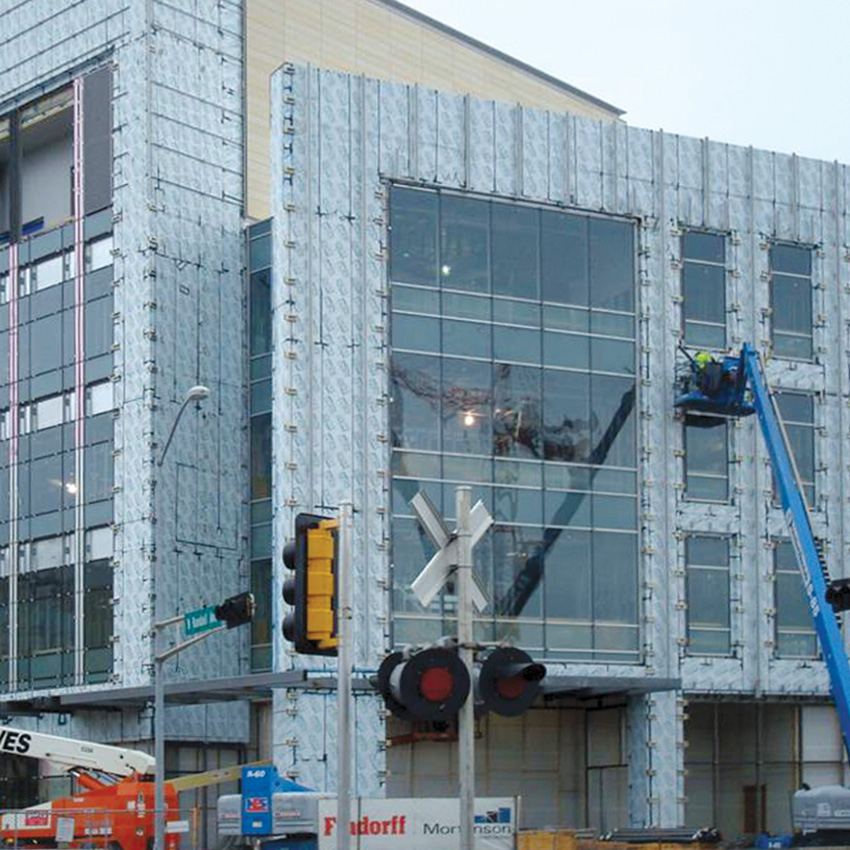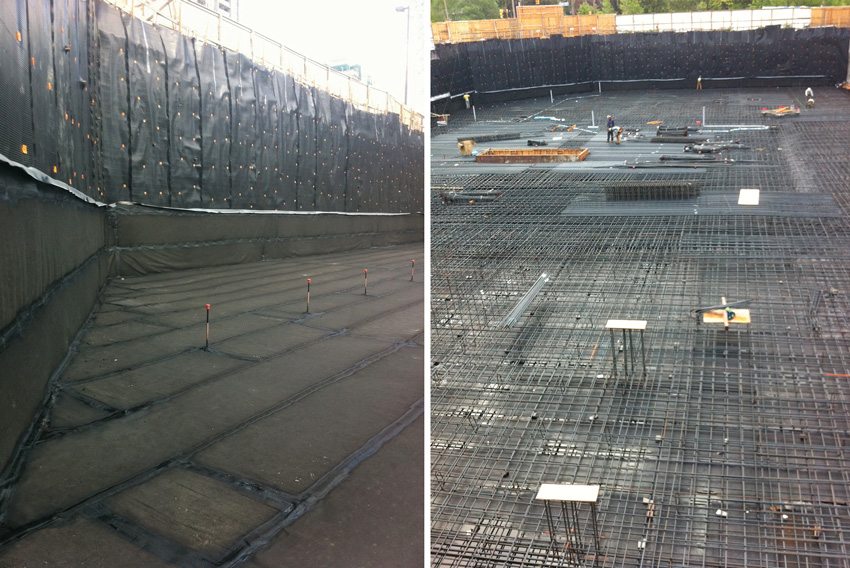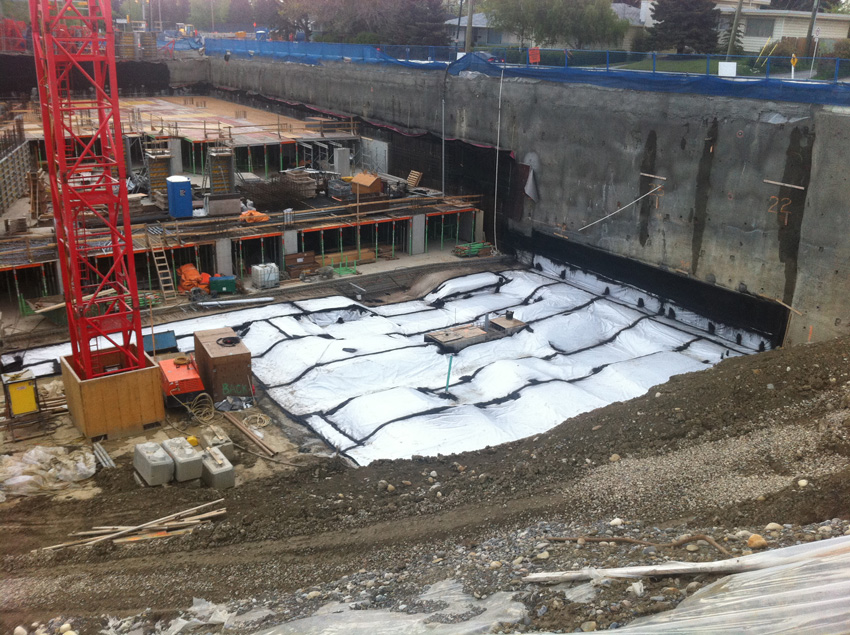Providing Thermal, Moisture, and Fire Barriers In Harsh Conditions
Complete, Coordinated Air and Water Barrier Systems
Behind a cladding system, the rest of a wall assembly needs to be covered with air and water barriers. In some cases, that can be the same material; in others, it is two different products or materials. Generally, conventional wisdom suggests that the fewer the layers the better for simplicity and cost effectiveness. However, there are other considerations. First is the need for a complete, continuous barrier. That means it is not just about the material itself, but the means to attach it, the connections at seams or joints, and the treatment around penetrations, such as piping, wires, or sleeves. Just one small gap can lead to major problems from air and moisture infiltration, and those gaps can occur in a lot of different ways. The drawings and specifications, for example, may not be all encompassing enough to address different design details. On-site construction conditions might leave wide joints that are impossible to seal with a sealant. During occupancy, differential movement of materials can lead to joint failure. All of these situations need to be considered to achieve a truly durable and continuous system.
Second, the transitions of the barrier systems to other types of construction need to be taken into account. While the window-wall transition is where most problems occur, connections at roof to wall, foundation to wall, corners, penetrations, drift joints, and floor deflection joints are also critical connections with the potential for increased performance problems, not to mention professional liability. All of this underscores the need for continuous, compatible product systems that address all of the connections on the building envelope where most failures occur, especially under harsh conditions, such as thermal and seismic movement, hurricane forces, and blast resistance.
Continuous connections and transitions throughout the building envelope are key to the longevity of the structure and its structural components, energy consumption, indoor air quality, and maintenance. Specifications left to “others” for these connections lead to uncertainty, interpretation on the job, and trial and error. Traditional methods may not work, particularly over the long term after continual exposure to thermal or dynamic movement. Depending on the conditions, they may not even work at the outset if existing conditions leave unsupported gaps that cannot be addressed by sealants, foams, or peel-and-stick flashing membranes.
Fortunately, products are available from single-source manufacturers that are complete, coordinated, and effective. Some have created innovative, engineered solutions for critical connections that provide visible assurance of a secure, continuous seal without voids. For example, one system consists of pre-engineered, finished aluminum and silicone materials that are assembled and attached to a window or wall assembly. These assemblies provide a more secure and flexible option for sealing connections, notably improving air and moisture management at critical transitions. This type of solution also allows for greater movement and deflection beyond what sealants or self-adhered membranes can provide, particularly where dissimilar materials, such as curtain wall and various assemblies, connect—all while maintaining water and air tightness. The system’s design absorbs thermal movement and wind-loading stresses. The use of translucent, formed silicone gaskets allows the installer and/or inspector to see through the gasket to verify the recommended amount of sealant is properly applied, while ribs in the gasket ensure a minimum sealant thickness. This type of solution also addresses the problems with compatibility in the connection from the air barrier to the wall system. By using a compatible silicone sealant to serve as an adhesive and wet seal to an air and water barrier system, a turnkey solution can be specified and obtained. It should be required that the manufacturer submits proof that the complete system has been developed and tested for compatibility and long-term air and moisture protection.
Architects and others who seek to work with an air and water barrier company during design may be pleased to discover that some offer significant assistance related to the most successful ways to use their integrated systems. These companies are as interested as the design team is in mitigating risk by working to prevent barrier failures during construction or occupancy. Such design assistance may include a full review of the building enclosure system, suggestions for integrated product and connectivity solutions, and even project-specific 3-D CAD details with installation instructions. During construction, they can assist with mock-ups to document performance, quality assurance through preconstruction coordination, applicator training, plus inspection and on-site testing, if desired. In some cases, they can even assist with full building enclosure commissioning in addition to providing full-system performance warranties.


Images courtesy of Tremco Commercial Sealants & Waterproofing
Continuous air and water barriers need to address the application of the material plus the details of seams, transitions, and connections, particularly around doors and windows.
Appropriate Levels of Waterproofing
Some portions of a building need more than air and moisture protection—they need full waterproofing protection. This is true in low-slope roofing systems, but it can also be true in more severe conditions both above grade and below grade. Anywhere the potential exists for bulk water to collect or build up against a wall or floor system, then waterproofing is needed to protect it. There are, of course, multiple ways to achieve such waterproofing, and sometimes the choices can be confounding in terms of determining what is best for a particular project. Further, it is not always appropriate to assume that a standard solution that worked well for one building is appropriate for another.
One approach to determining the most appropriate solution is based on a concept called “redundant field-fabricated composite design,” which is the integration of multiple waterproofing types into one organized system. This concept allows architects and designers to customize the system, protecting their structure based upon the site conditions, performance expectations, and budget considerations of the project team. It also allows for an assessment of the severity of the waterproofing needs and allows for a system to be selected based on that need. Essentially, the approach is to be sure that the products and system used will keep building structures dry and safe, but to use the appropriate level of protection needed—not overdue it unnecessarily, nor come up short on meeting the true waterproofing need.
Some manufacturers recognize this approach to waterproofing and have made it easier to understand the differences between different layers or types of protection using their commercial waterproofing products. Essentially, they provide a “good, better, best” approach to waterproof protection through different system configurations that are suitable to protect below-grade foundations and exposed decks. Such field-installed composite waterproofing systems are defined by multiple layers. The first layer is a spray fluid-applied membrane that covers concrete or masonry. Commonly, this is a water-based polymer modified asphalt (PMA) membrane. The second layer is a reinforcing fabric commonly made from polyester to take up any undue stresses from movement. An additional layer can be specified that allows for some added thickness to absorb and drain water away. This layer is commonly made of bentonite or a similar water absorbing and draining material. The final outer layer protects the drainage medium as well as the primary membrane. Such outer layers can be a composite made up of a high-density polyethylene (HDPE) core and nonwoven polypropylene fabric drainage or a polypropylene core and polypropylene fabric.

Photos courtesy of Epro
Complete waterproofing based on the concept of redundant field-fabricated composite design provides below-grade walls and decks the degree of protection needed based on the choices made for individual component layers.
The goal of this holistic approach to waterproofing is to create a series of barriers, drainage channels, and reinforcing protection over a concrete or masonry wall, slab on grade, or other structure. Each of these layers can be specified or selected based on the particular needs of the project with properties that suit the harshness of the building site or the degree of protection required. By working with one manufacturer that provides a complete system with the multiple choices, the design can be simplified and the performance maximized. At least one manufacturer provides such a system that truly combines all types of waterproofing into one coordinated system.
In addition to the actual system, it is important to understand how the edges of these systems are detailed. On vertical or sloped walls, a continuous metal termination strip across the top of a hybrid membrane allows for the transition between the area above and below the waterproofed area, but it also holds the drainage barrier in place. The bottom needs to account for the footing condition and allow the vertical drainage to be picked up, channeled, and moved away from the wall. That may mean adding some products specifically designed to be compatible with the rest of the waterproofing system that can be integrated as a horizontal or sloped drainage medium. Finally, the collected water must be able to drain away from the wall altogether either through drain tiles or piping or through the use of backfill materials that will allow for water dispersion.
Horizontal conditions, such as concrete floor slabs on grade, can be equally demanding, particularly if the groundwater level is high or the soil around and under the slab becomes saturated due to heavy rains. In order to prevent water infiltration, the waterproofing system needs to be continuous under the floor slab and connect with the wall edges to form a continuous barrier to drain and stop the water. This need can be exacerbated if freezing conditions are encountered near the building or if seismic activity is prevalent. In these cases, the waterproofing membrane system is subject to additional stresses and pressures beyond the normal hydrostatic concerns. Hybrid or composite systems that incorporate the multiple attributes of membrane, reinforcing, drainage, and protection into one coordinated system are most likely to perform well under these conditions compared to less complete or less coordinated approaches from multiple manufacturers.
Overall, hybrid, composite waterproofing systems leverage the attributes of multiple waterproofing technologies into a coordinated system. This enables building owners to receive a better overall value by receiving the appropriate level of protection, provided the architect selects the best mix of products and barriers to do the job efficiently. Further, by combining and leveraging the benefits of each waterproofing component, installation times can be decreased while overall protection increases compared to other types of waterproofing systems.

Photo courtesy of Epro/Jason Whitfield
Waterproofing systems can be subjected to stresses beyond hydrostatic pressure alone. The 1-million-square-foot West LRT Tunnel constructed in Calgary, Alberta, Canada, during the winter time is an example of the need for waterproofing to resist stresses from cold temperatures and possible seismic activity.
Notice

www.cladiators.com

www.eproinc.com


www.tremcosealants.com/products/proglaze-eta.aspx









